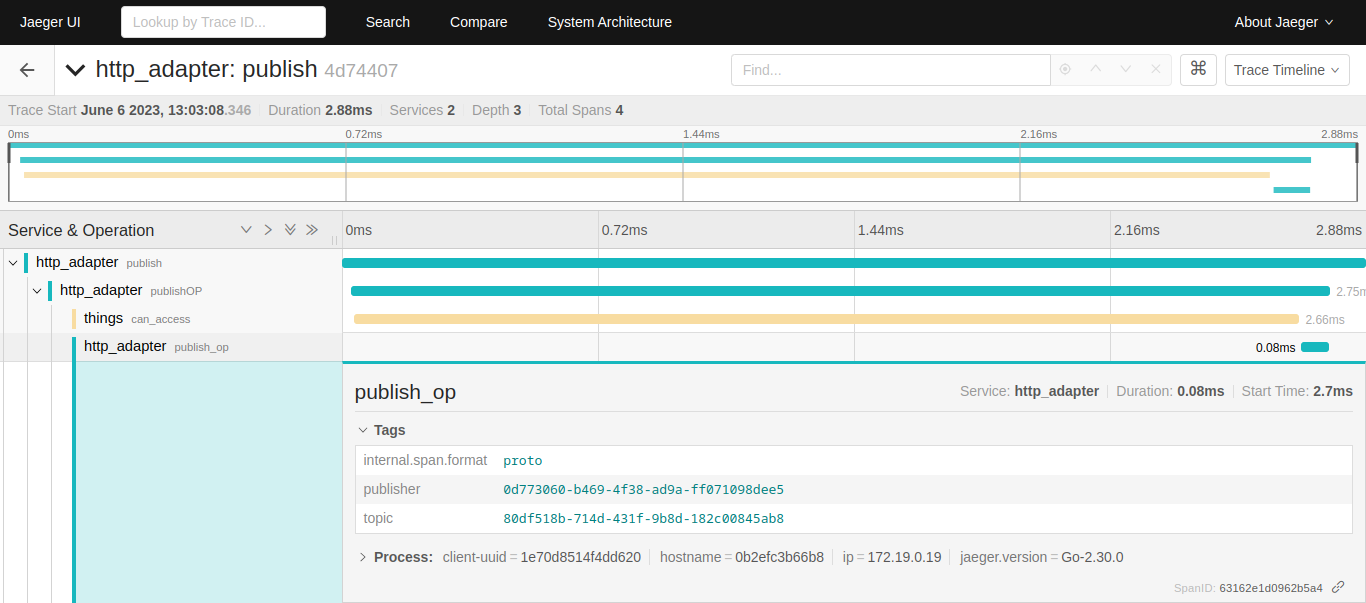Tracing
Distributed tracing is a method of profiling and monitoring applications. It can provide valuable insight when optimizing and debugging an application. SuperMQ includes the Jaeger open tracing framework as a service with its stack by default.
Launch
The Jaeger service will launch with the rest of the SuperMQ services. All services can be launched using:
make run
The Jaeger UI can then be accessed at http://localhost:16686 from a browser. Details about the UI can be found in Jaeger's official documentation.
Configure
The Jaeger service can be disabled by using the scale flag with docker-compose up and setting the jaeger container to 0.
--scale jaeger=0
Jaeger uses 5 ports within the SuperMQ framework. These ports can be edited in the .env file.
| Variable | Description | Default |
|---|---|---|
| SMQ_JAEGER_PORT | Agent port for compact jaeger.thrift protocol | 6831 |
| SMQ_JAEGER_FRONTEND | UI port | 16686 |
| SMQ_JAEGER_COLLECTOR | Collector for jaeger.thrift directly from clients | 14268 |
| SMQ_JAEGER_CONFIGS | Configuration server | 5778 |
| SMQ_JAEGER_URL | Jaeger access from within SuperMQ | jaeger:6831 |
Message Tracing
SuperMQ provides for tracing of messages ingested into the SuperMQ platform. The message metadata such as topic, sub-topic, subscriber and publisher is also included in traces. 
The messages are tracked from end to end from the point they are published to the consumers where they are stored. 
Example
As an example for using Jaeger, we can look at the traces generated after provisioning the system. Make sure to have ran the provisioning script that is part of the Getting Started step.
Before getting started with Jaeger, there are a few terms that are important to define. A trace can be thought of as one transaction within the system. A trace is made up of one or more spans. These are the individual steps that must be taken for a trace to perform its action. A span has tags and logs associated with it. Tags are key-value pairs that provide information such as a database type or http method. Tags are useful when filtering traces in the Jaeger UI. Logs are structured messages used at specific points in the trace's transaction. These are typically used to indicate an error.
When first navigating to the Jaeger UI, it will present a search page with an empty results section. There are multiple fields to search from including service, operation, tags and time frames. Clicking Find Traces will fill the results section with traces containing the selected fields.

The top of the results page includes a scatter plot of the traces and their durations. This can be very useful for finding a trace with a prolonged runtime. Clicking on one of the points will open the trace page of that trace.
Below the graph is a list of all the traces with a summary of its information. Each trace shows a unique identifier, the overall runtime, the spans it is composed of and when it was ran. Clicking on one of the traces will open the trace page of that trace.

The trace page provides a more detailed breakdown of the individual span calls. The top of the page shows a chart breaking down what spans the trace is spending its time in. Below the chart are the individual spans and their details. Expanding the spans shows any tags associated with that span and process information. This is also where any errors or logs seen while running the span will be reported.
This is just a brief overview of the possibilities of Jaeger and its UI. For more information, check out Jaeger's official documentation.